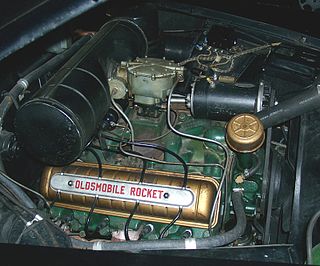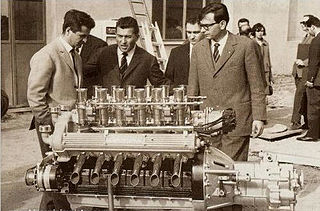The Y-block engine is a family of small block overhead valve V8 automobile engines produced by Ford Motor Company. The engine is well known and named for its deep skirting, which causes the engine block to resemble a Y. It was introduced in 1954 as a more modern replacement for the outdated side-valved Ford Flathead V8 and was used in a variety of Ford vehicles through 1964.

The Chrysler B and RB engines are a series of big-block V8 gasoline engines introduced in 1958 to replace the Chrysler FirePower engines. The B and RB engines are often referred to as "wedge" engines because they use wedge-shaped combustion chambers; this differentiates them from Chrysler's 426 Hemi big block engines that are typically referred to as "Hemi" or "426 Hemi" due to their hemispherical shaped combustion chambers. The corporation had been seeking a smaller and lighter replacement for its FirePower engines, in part because new styling dictates meant moving the engine forward in the chassis which negatively affected weight distribution.

The Chevrolet small-block engine is a series of gasoline-powered V8 automobile engines, produced by the Chevrolet division of General Motors in two overlapping generations between 1954 and 2003, using the same basic engine block. Referred to as a "small-block" for its size relative to the physically much larger Chevrolet big-block engines, the small-block family spanned from 262 cu in (4.3 L) to 400 cu in (6.6 L) in displacement. Engineer Ed Cole is credited with leading the design for this engine. The engine block and cylinder heads were cast at Saginaw Metal Casting Operations in Saginaw, Michigan.

The Pontiac V8 engine is a family of overhead valve 90° V8 engines manufactured by the Pontiac Division of General Motors Corporation between 1955 and 1981. The engines feature a cast-iron block and head and two valves per cylinder. Engine block and cylinder heads were cast at Saginaw Metal Casting Operations then assembled at Tonawanda Engine before delivery to Pontiac Assembly for installation.
After an early flirtation with V-twin engines, Mazda's small cars of the 1960s were powered by OHV straight-2 and straight-4 engines. This family lasted from 1961 until the mid-1970s. Today, Mazda's keicars use Suzuki engines. It was produced at the Hiroshima Plant in Hiroshima, Japan.

The Oldsmobile V8, also referred to as the Rocket, is a series of engines that was produced by Oldsmobile from 1949 until 1990. The Rocket, along with the 1949 Cadillac V8, were the first post-war OHV crossflow cylinder head V8 engines produced by General Motors. Like all other GM divisions, Olds continued building its own V8 engine family for decades, adopting the corporate Chevrolet 350 small-block and Cadillac Northstar engine only in the 1990s. All Oldsmobile V8s were assembled at plants in Lansing, Michigan while the engine block and cylinder heads were cast at Saginaw Metal Casting Operations.

The Buick V8 is a family of V8 engines produced by the Buick division of General Motors (GM) between 1953 and 1981. All were 90° water-cooled V8 OHV pushrod engines, and all were naturally aspirated except one turbocharged version of the 215.

The Lamborghini V12 refers to the flagship V12 engine used by Lamborghini. Lamborghini has had two generations of V12 engines through their history, both of which were developed in-house. The first-generation Lamborghini V12 was a sixty degree (60°) V12 petrol engine designed by Lamborghini, and was the first internal combustion engine ever produced by the firm.

The Prince G-series engine was the company's only straight-four and straight-six engines which began production in 1955. A number of variations were made, with both OHV and OHC heads. A diesel four-cylinder with 1.9 L (1,862 cc) was also built, called the D-6. The G series was used in the Skyline, the Laurel, and the Gloria from the 1950s to the early 1970s.

The Chrysler Hemi engine, known by the trademark Hemi or HEMI, refers to a series of high-performance American overhead valve V8 engines built by Chrysler with hemispherical combustion chambers. Three generations have been produced: the FirePower series from 1951 to 1958; a famed 426 cu in (7.0 L) race and street engine from 1964-1971; and family of advanced Hemis (displacing between 5.7 L 6.4 L from 2003 to the present.

The Subaru 1000 is a car produced by the Japanese company Fuji Heavy Industries from 1966 to 1969. It was the first-and-only Subaru with front-wheel drive that was in the Japanese government "compact car" classification. Previous Subaru models such as the Subaru 360 and the Sambar had been rear-engined, rear-wheel drive kei cars.

The Subaru EJ engine is a series of four-stroke automotive engines manufactured by Subaru. They were introduced in 1989, intended to succeed the previous Subaru EA engine. The EJ series was the mainstay of Subaru's engine line, with all engines of this series being 16-valve horizontal flat-fours, with configurations available for single, or double-overhead camshaft arrangements. Naturally aspirated and turbocharged versions are available, ranging from 96 to 310 hp. These engines are commonly used in light aircraft, kit cars and engine swaps into air-cooled Volkswagens, and are also popular as a swap into Volkswagen T3/Vanagons powered by the Volkswagen Wasserboxer engine. Primary engineering on the EJ series was done by Masayuki Kodama, Takemasa Yamada and Shuji Sawafuji of Fuji Heavy Industries, Subaru's parent company.

The Subaru EA engine is a series of automobile internal combustion engines manufactured by Subaru, a division of Fuji Heavy Industries. All EA series engines are of a flat-4 design, and have always been water cooled.

The EF is an automotive engine made by Subaru, introduced in 1984 for the Subaru Justy. It is a water-cooled, straight-three, four-stroke engine with a belt-driven single overhead camshaft, and a chain-driven balance shaft. It has an alloy cylinder head and a closed deck iron engine block with a bore spacing of 86.0 mm (3.39 in). The two-cylinder EK23 engine is closely related to the EF series, sharing the same bore spacing and overall design. The export market 665 cc EK42 motor even shares the bore and stroke of the EF10.

The EN series engine is a four-cylinder, four-stroke engine used in kei cars sold by Subaru in Japan, succeeding the EK family of two-cylinder engines previously used in Subaru kei cars from 1958 to 1989. The EN family was introduced in 1989 and discontinued in 2012.

The Toyota NR engine family is a series of small inline-four piston engines designed and manufactured by Toyota, with capacities between 1.2 and 1.5 litres.















